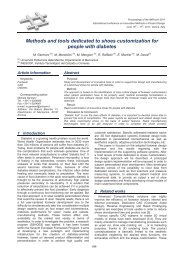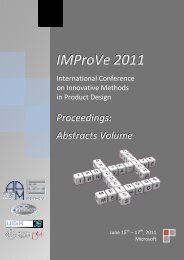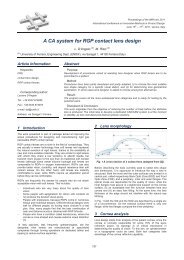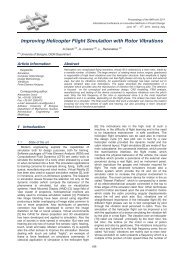IMProVe 2011 - Proceedings
IMProVe 2011 - Proceedings
IMProVe 2011 - Proceedings
You also want an ePaper? Increase the reach of your titles
YUMPU automatically turns print PDFs into web optimized ePapers that Google loves.
Reverse Engineering<br />
Automation of the finishing process<br />
of steel yacht hulls based on optical scanning<br />
A. Paoli (a), A. V. Razionale (a), D. Saba (a)<br />
(a) University of Pisa, Department of Mechanical, Nuclear and Production Engineering<br />
Abstract:<br />
Purpose:<br />
The manufacturing of large yacht hulls is a complex process in the shipbuilding industry.<br />
The traditional approach is based on the pre-fabrication of large steel panels that are<br />
welded together to form 3D superstructure assemblies. One of the most relevant aspects<br />
of a yacht is its visual impact. For this reason, a finishing phase is usually carried out in<br />
order to obtain a final target surface with smooth curvature. Current methodologies<br />
mainly rely on manual processes thus requiring a great amount of time and wellexperienced<br />
workers.<br />
Method:<br />
This paper introduces an innovative methodology representing the basis for the<br />
automation of the finishing phase of large yacht hulls. The proposed approach is based on<br />
the measurement of the as-built hull surface through the integration of an active stereo<br />
vision system and a complex mechanical tracking system. A procedure to define the target<br />
surface has been developed by integrating information deriving from both the design and<br />
the as-built shapes.<br />
Result:<br />
The developed methodology has been tested on a broadside region of the hull of a 59<br />
metres yacht assembled within a shipyard. A target surface, differing as little as possible<br />
from the design surface, has been modelled in order to obtain a uniform curvature shape.<br />
A finishing phase has then been carried out by applying a layer of filler and by milling the<br />
hull’s surface.<br />
Discussion & Conclusion:<br />
Results obtained have demonstrated the feasibility of the proposed approach, speeding<br />
up the whole process and guaranteeing fair reflection line patterns on the manufactured<br />
surface.<br />
Keywords: Shipbuilding industry, Reverse engineering, Robotic system, Surface modelling.<br />
Corresponding Author: Alessandro Paoli<br />
Tel.: +39 050 2218174<br />
Fax.: +39 050 2218065<br />
e-mail: a.paoli@ing.unipi.it<br />
Address: Largo Lucio Lazzarino 1, - 56100 Pisa - Italy<br />
June 15 th – 17 th , <strong>2011</strong>, Venice, Italy<br />
74<br />
<strong>IMProVe</strong> <strong>2011</strong> - <strong>Proceedings</strong>










